Technology for Welding Copper with Blue Diode Lasers Contributes to Improving EV Manufacturing Precision and Efficiency
Contributing to Electrification
and Efficiency of Mobility
Currently, there is strong growth in the adoption of electric vehicles (EVs). Such electric vehicles use large quantities of copper, which has a high-conductivity, for motor windings, batteries and various wiring systems. EVs contain about 2 to 4 times more copper than gasoline cars. Consequently, demand has been growing for copper welding technologies required in electric vehicle manufacturing.
Low Light Absorption Makes Copper Difficult to Weld
Generally, lasers with an infrared wavelength of about 10 μm or 1 μm, such as CO2 lasers or fiber lasers, are used for welding metals.
Unfortunately, copper surfaces has almost no absorbance for light in these wavelength ranges, so it reflects off the surface and does not heat up, making it difficult to weld well. However, in the blue region of 450 nm, where the wavelength is much shorter, the light absorption rates of copper increase sharply, which enables much higher quality and more efficient welding than before.
Shimadzu is focusing on the wavelengths in the blue region and has developed a high-output/high-brightness blue diode laser that is ideal as a light source for welding copper.

Light Absorption Characteristics of Metal vs Laser Wavelength
Source: Marvin J. Weber Handbook of Optical Materials (2003)
Combining Techniques to Increase the Output of Blue Diode Lasers
Blue laser light sources have an ideal wavelength for copper processing. Recently, the output of a blue diode laser element has been remarkably increased, but the output of a single element is insufficient as a light source for copper welding. Therefore, Shimadzu uses techniques for combining a plural of blue diode laser elements to increase the laser output.
Note: Shimadzu began working on development of the combining technique to increase the laser output in 2014. Shimadzu increased output to 20 W by the next year and dramatically increased output through participation in an industry-academia-government collaborative project starting in 2016, achieving 500 W in 2019 and 1500 W by the end of FY2020.
The Characteristics of Three Combining Techniques
Combining techniques refer to mainly three methods for condensing light from multiple diode laser elements into a single optical fiber.
- Spatial Beam Combining

- This uses optical fiber-coupling or other means to multiplex multiple laser beams spatially.
- Wavelength Beam Combining
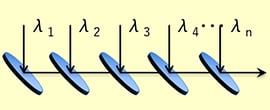
- This uses wavelength selective elements to couple multiple laser light with different wavelengths.
- Polarization Beam Combining

- This uses a polarizing element to multiplex beams with different polarities.
Shimadzu Combining Technique Uses All Three Combining Methods
In addition to high power, another key characteristic of Shimadzu blue diode lasers is high brightness. High brightness allows more light to be applied to a focus point and heat can intensively be transferred, enabling high-precision, high-speed, and highly productive processing.
However, there are limits to how much brightness can be increased based on only one combining method. Therefore, Shimadzu applied the own beam combining technique using three methods, to achieve both high output and high brightness.
Example of Using a Blue Diode Laser for Welding in Electric Vehicles
Welding Rivets for Li-ion Batteries
Copper rivets and washers are irradiated with blue laser for one second.

Welding EV Motor Electrodes
A stack of five 0.1 mm-thick copper sheets is irradiated from above with blue laser in one direction.
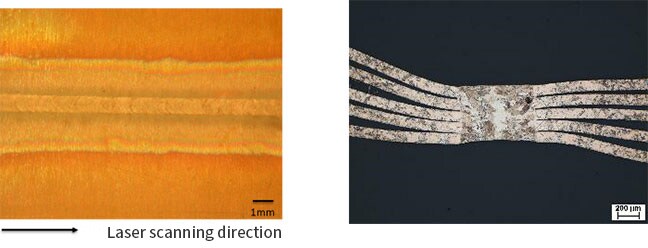
Welding Bus Bars for EV Motors
A 1.5 kW output blue laser is used to weld a total copper plate thickness of 1 mm.

Surface

Back side
Welding Electrodes for Li-ion Batteries
A 1.5 kW output blue laser is used to weld 30 sheets of 0.01 mm-thick copper foil to a 0.4 mm-thick copper plate.
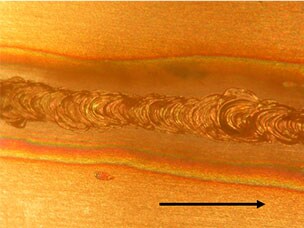
Copper plate side (Laser irradiation side)
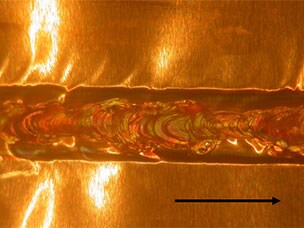
Copper foil side
Welding EV Motor Coil Windings
Copper rectangular wire ends are welded quickly and with high-quality.
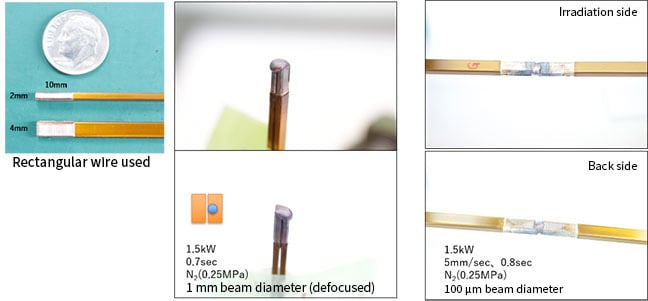
Because blue lasers heat copper materials immediately, the rectangular copper wires ends can be welded with pinpoint accuracy and copper sheets can be welded from start to finish with a constant weld width.
Future Improvements to Blue Diode Laser Technology
In December 2020, Shimadzu partnered with Professor Tsukamoto from Osaka University, an expert in laser processing, and with Nichia Corporation and Furukawa Electric Co., Ltd., to establish the Blue Diode Laser Welding Research Society for the purpose of gathering and exchanging information about R&D on blue diode lasers, corresponding processing technologies, and broad use of the lasers in society. As part of their activities, the society offers opportunities where society members can verify copper welding processes using Shimadzu blue diode lasers. In the future, such feedback will be used to engage in further development work for making improvements toward achieving an even more practical laser light source.